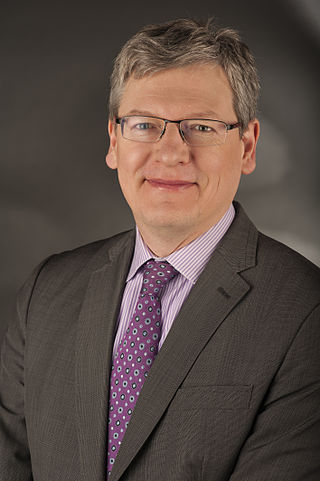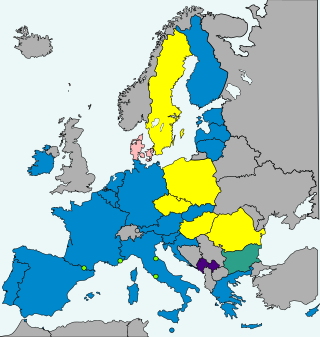
The economy of Croatia is a high-income, service-based social market economy with the tertiary sector accounting for 70% of total gross domestic product (GDP). Croatia has a fully integrated and globalized economy. Croatia's road to globalization started as soon as the country gained independence, with tourism as one of the country's core industries dependent on the global market. Croatia joined the World Trade Organization in 2000, NATO in 2009, has been a member of the European Union since 1 July 2013, and it finally joined the Eurozone and the Schengen Area on January 1st 2023. Croatia is also negotiating membership of OECD organization, which it hopes to join by 2025. Further integration into the EU structures will continue in the coming years, including participation in ESA, CERN as well as EEA membership in the next 24 months.
The Republic of Croatia is a sovereign country at the crossroads of Central Europe, Southeast Europe, and the Mediterranean that declared its independence from Yugoslavia on 25 June 1991. Croatia is a member of the European Union (EU), United Nations (UN), the Council of Europe, NATO, the World Trade Organization (WTO), Union for the Mediterranean and a number of other international organizations. Croatia has established diplomatic relations with 187 countries. The president and the Government, through the Ministry of Foreign and European Affairs, co-operate in the formulation and implementation of foreign policy.

The economy of Slovenia is a developed economy, and the country enjoys a high level of prosperity and stability as well as above-average GDP per capita by purchasing power parity at 83% of the EU28 average in 2015. Nominal GDP in 2022 is 62.191 billion USD, nominal GDP per capita (GDP/pc) in 2022 is USD 29,469. The highest GDP/pc is in central Slovenia, where the capital city Ljubljana is located. It is part of the Western Slovenia statistical region, which has a higher GDP/pc than eastern Slovenia.

The International Bank for Reconstruction and Development (IBRD) is an international financial institution, established in 1944 and headquartered in Washington, D.C., United States, that is the lending arm of World Bank Group. The IBRD offers loans to middle-income developing countries. The IBRD is the first of five member institutions that compose the World Bank Group. The initial mission of the IBRD in 1944, was to finance the reconstruction of European nations devastated by World War II. The IBRD and its concessional lending arm, the International Development Association (IDA), are collectively known as the World Bank as they share the same leadership and staff.

The European Bank for Reconstruction and Development (EBRD) is an international financial institution founded in 1991. As a multilateral developmental investment bank, the EBRD uses investment as a tool to build market economies. Initially focused on the countries of the former Eastern Bloc it expanded to support development in more than 30 countries from Central Europe to Central Asia. Similar to other multilateral development banks, the EBRD has members from all over the world, with the biggest single shareholder being the United States, but only lends regionally in its countries of operations. Headquartered in London, the EBRD is owned by 71 countries and two European Union institutions, the newest shareholder being Algeria since October 2021. Despite its public sector shareholders, it invests in private enterprises, together with commercial partners.
The Government of Croatia, formally the Government of the Republic of Croatia, commonly abbreviated to Croatian Government, is the main executive branch of government in Croatia. It is led by the president of the Government, informally abbreviated to premier or prime minister. The prime minister is nominated by the president of the Republic from among those candidates who enjoy majority support in the Croatian Parliament; the candidate is then chosen by the Parliament. There are 20 other government members, serving as deputy prime ministers, government ministers or both; they are chosen by the prime minister and confirmed by the Parliament (Sabor). The Government of the Republic of Croatia exercises its executive powers in conformity with the Croatian Constitution and legislation enacted by the Croatian Parliament. The current government is led by Prime Minister Andrej Plenković.

Stari Most, also known as Mostar Bridge, is a rebuilt 16th-century Ottoman bridge in the city of Mostar in Bosnia and Herzegovina that crosses the river Neretva and connects the two parts of the city. On 9 November 1993 Stari Most collapsed due to shelling by the Croatian Defence Council (HVO) during the Croat–Bosniak War because the Army of the Republic of Bosnia and Herzegovina (ARBiH) used it as a military supply line. The Old Bridge was deemed a legitimate military target by the International Criminal Tribunal for the former Yugoslavia, since the ARBiH used it for military purposes. Subsequently, a project was set in motion to reconstruct it; the rebuilt bridge opened on 23 July 2004.
The IDBI Bank Limited is a development finance institution under the ownership of Life Insurance Corporation of India and Government of India. It was established in 1964 as Industrial Development Bank of India, a development finance institution, which provided financial services to industrial sector. In 2005, the institution was merged with its commercial division, IDBI Bank, forming the present-day banking entity and was categorised as "other development finance institution" category. Later in March 2019, Government of India asked Life Insurance Corporation to infuse capital in the bank due to high NPA and capital adequacy issues and also asked LIC to manage the bank to meet the regulatory norms. IDBI was put under Prompt corrective action of the RBI and on 10th March 2021 IDBI came out of the PCA. At present direct and indirect shareholding of Government of India in IDBI Bank is approximately 95%, which Government of India (GoI) vide its communication F.No. 8/2/2019-BO-II dated December 17, 2019, has clarified and directed all Central/State Government departments to consider IDBI Bank for allocation of Government Business. Many national institutes find their roots in IDBI like SIDBI, EXIM, National Stock Exchange of India, SEBI, National Securities Depository Limited.
The Chernobyl Shelter Fund (CSF) was set up in December 1997 with the purpose of funding the Shelter Implementation Plan (SIP). The aim of the fund is to create conditions for the dismantling and decomposition of the radiation contaminated structures. At the end of the eight- to nine-year project, estimated to cost US$768 million, the Shelter will be transformed into a stable and environmentally safe system for an estimated 100 years. The most visible aspect of this transformation will be the construction of the New Safe Confinement. The European Bank for Reconstruction and Development (EBRD) was entrusted with managing the CSF.

The A5 motorway is a motorway in Croatia spanning 83.6 kilometres (51.9 mi). It connects Osijek, the largest city in Slavonia region, to the Croatian motorway network at the Sredanci interchange of the A3 motorway. The A5 represents a significant north–south transportation corridor in Croatia and is a part of the European route E73. The A5 motorway route also follows Pan-European corridor Vc. In addition to Osijek, the A5 motorway also passes near Đakovo and Beli Manastir.

Croatia–India relations are the bilateral ties between Croatia and India. Diplomatic relations between two countries were officially established on 9 July 1992 following Croatia's independence from SFR Yugoslavia.
A national development bank is a development bank created by a country's government that provides financing for the purposes of economic development of the country.

Energy in Croatia describes energy and electricity production, consumption and import in Croatia.

László Andor is a Hungarian economist. From 2010 to 2014 he was Commissioner for Employment, Social Affairs and Inclusion in the Barroso II administration of the European Commission. From 2005 to 2010 he was a Member of the Board of Directors of the European Bank for Reconstruction and Development (EBRD), representing the Czech Republic, Croatia, Hungary and Slovakia.

D23 state road, connects cities and towns of Duga Resa, Josipdol and Senj, to the state road network of Croatia, and most notably to A1 motorway in Žuta Lokva interchange, as well as two major state roads - D3 and D8, located at the northern terminus and the southern terminus of the road respectively. The road is 103.9 km (64.6 mi) long. The route comprises a significant number of urban intersections, in segments of the road running through Duga Resa and Senj.
Martina Dalić is a Croatian economist and finance official who was a Deputy Prime Minister of Croatia and Minister of Economy, Small and Medium Entrepreneurship and Crafts in the Cabinet of Andrej Plenković.

The Ombla is a short river in Croatia, northeast of Dubrovnik. Its course is approximately 30 metres long, and it empties into the Rijeka Dubrovačka, ria formed by the Adriatic Sea near Komolac in Dubrovnik-Neretva County. Rijeka Dubrovačka is actually a ria, a flooded river valley formed through changes in sea surface elevation on a geologic time scale. The river rises as a karst spring fed by groundwater replenished by Trebišnjica, which is an influent stream flowing in Popovo Polje, in the immediate hinterland of the Ombla. The elevation difference between the river's source and its mouth is just over 2 metres. The average discharge of the river is 24.1 cubic metres per second. The drainage basin of the Ombla encompasses 600 square kilometres and, besides the short surface course, includes only groundwater flow.

Croatia adopted the euro as its currency on 1 January 2023, becoming the 20th member state of the eurozone. A fixed conversion rate was set at 1 € = 7.5345 kn.

The World Bank is an international financial institution that provides loans and grants to the governments of low- and middle-income countries for the purpose of pursuing capital projects. The World Bank is the collective name for the International Bank for Reconstruction and Development (IBRD) and International Development Association (IDA), two of five international organizations owned by the World Bank Group. It was established along with the International Monetary Fund at the 1944 Bretton Woods Conference. After a slow start, its first loan was to France in 1947. In the 1970s, it focused on loans to developing world countries, shifting away from that mission in the 1980s. For the last 30 years, it has included NGOs and environmental groups in its loan portfolio. Its loan strategy is influenced by the United Nations' Sustainable Development Goals, as well as environmental and social safeguards.













